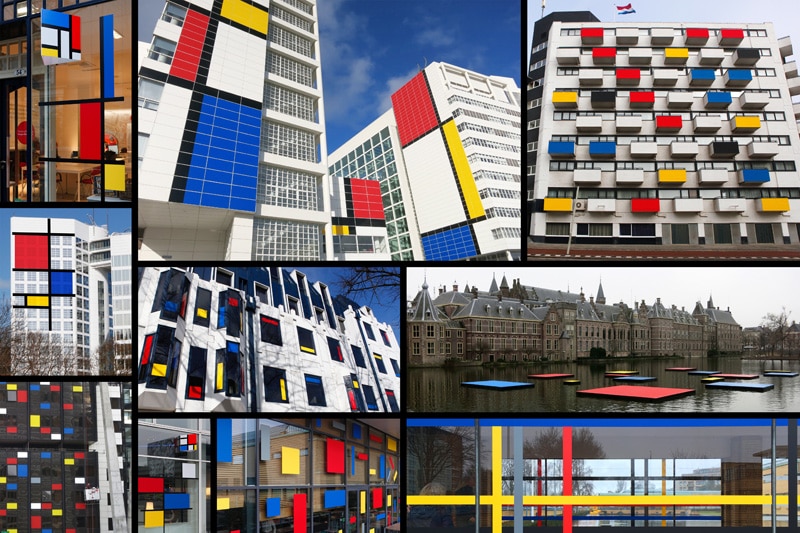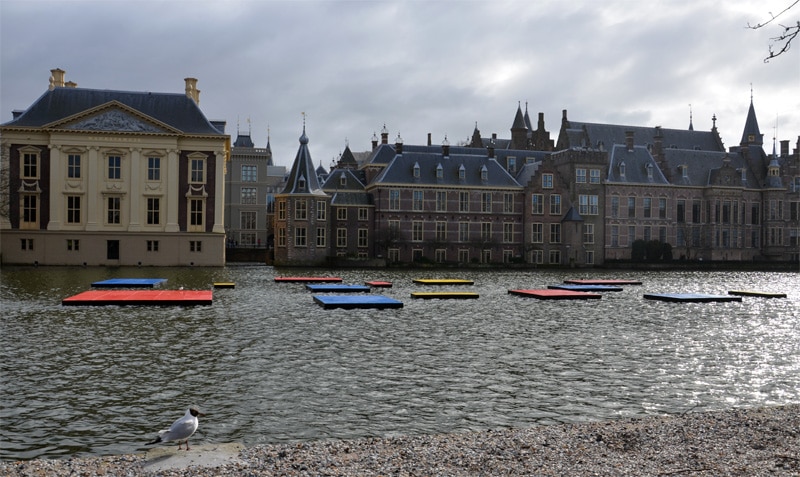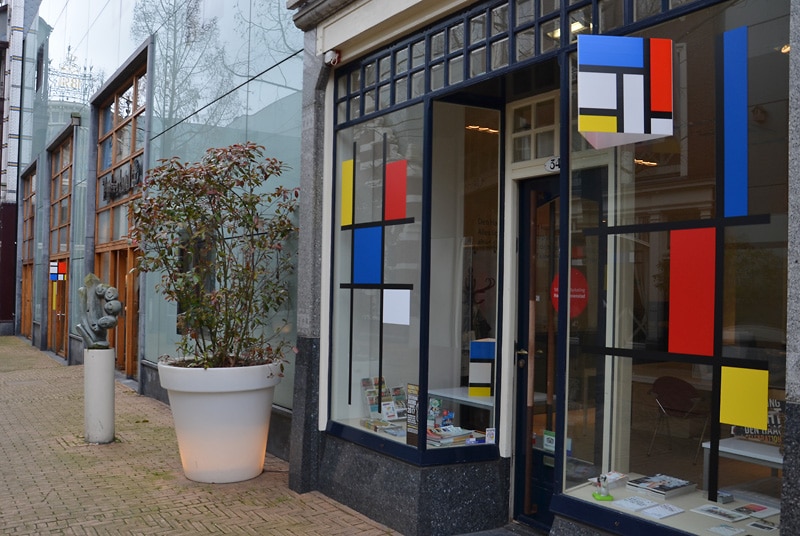On Piet Mondrian's birthday, 7 March, the municipality of The Hague offered its residents a colossal decorated cake. It is part of a very active campaign around 100 years of De Stijl. While the Gemeentemuseum is presenting three substantive Stijl exhibitions this year, The Hague is going all out with Stijl imitations and plastered shop windows. A contradiction? Less than it seems, because these citydressing happens under the auspices of the museum.

Take the campaign cry "The Hague colours Mondrian" literally. From the wall of the city hall to decking in the Hofvijver, from cinema windows to hotel balconies, not to mention countless shops in the city centre - the colour planes and lines really are everywhere. How so? There were no major Stijl artists based in The Hague and Theo van Doesburg was more the central figure in De Stijl than Mondrian. So why the huge Mondrian campaign?
Celebrate
My first point of enquiry is the Gemeentemuseum. Spokesperson Anne de Haij informs that the museum does not only focus on Mondrian. With the three exhibitions alongside the permanent De Stijl display, "we are celebrating the anniversary and greatness of De Stijl as a movement and leading contribution to international art. And of one of the Stijl artists who, after De Stijl, also became the world's most famous modern artist, Piet Mondrian.'
According to De Haij, the Hague campaign was initiated by the municipality and The Hague Marketing. "Probably based on the idea that The Hague, with the world's largest collection of Mondriaans, is Piet's 'international home'."
So on to The Hague Marketing. There, Mieke Smid explains: 'With the theme year, we are celebrating this anniversary, we are celebrating Mondriaan. The events, exhibitions, merchandise, routes, menus, lectures, hotel rooms, city dressing and toolkits for SMEs should create recognisability, evoke the feeling of celebration. This play of colours and lines is recognisable and does exactly that! All this together provides a reason to come to The Hague right now, to experience the city, to stay there and to celebrate with it.'
Citydresser
Through Den Haag Marketing, I come into contact with Matthijs de Groot, hired by the municipality as quartermaster for the campaign. He works together with citydresser Madje Vollaers from Studio Vollaers Black. This company previously decorated the Erasmus Bridge in Rotterdam, among others.

De Groot interests partners in the city to join the Mondrian campaign. 'We are looking at places that high traffic are and strategically well located. A lot of people have to pass by and they have to be highly visible.' Vollaerszwart then creates a design.
But how much do the red-yellow-blue creations really have to do with Mondrian or De Stijl? Vollaers: 'We do not recreate existing works of art, but are inspired by De Stijl. Actually, we ourselves work as a kind of Style artists: we look at a building and turn it into a Style artwork in the manner of Van der Leck or Van Doesburg. The link of De Stijl to architecture is easy, of course.'
Foils and adhesives
Vollaers creates a unique design for each building, but is not entirely free to do so. 'The Gemeentemuseum does an aesthetic review. I make a plan for a building and seek approval from the museum.'
Once the design is approved - and so far all designs have been approved - Vollaers starts working with adhesive films and special adhesives. After all, everything has to be removable afterwards. The costs are largely borne by the owners of the building to be decorated.

A special story lies behind the decking in the Hofvijver. Vollaers: 'Mondrian had 14 red, yellow and blue canvases in his studio and started making a new composition of them every day.'
'My grandchild can do that too'
Besides the "big" citydressing, there is the free toolkit for shopkeepers. With a "broker's sign", black tape and a piece of foil of each of the three Style colours, they can get to work themselves and compete for the most beautiful Mondrian window display. This produces nice compositions, but also endearing trysts and downright horrors.
De Groot: 'Haha, you should ask the shopkeepers, they often find it disappointing how easy it is to make something really beautiful. Besides, a Mondrian window is indeed different from a real Mondrian.'

Atelier in Laren
To the profusion of Style colours and funding therein, the reality of a hundred years ago stands out. At the very thorough and beautifully designed exhibition at the Gemeentemuseum, we see that Piet Mondrian had his studio in a shabby hut in Laren around 1916-18, as the First World War prevented him from returning to his home town of Paris.
He met Bart van der Leck at Mrs Kröller-Müller's house and - surprise surprise - it was in The Hague, on Lange Voorhout. Van der Leck was working with primary colours, Mondrian was working more and more abstractly. Thus the gentlemen inspired each other without being especially friends. And all this well before eventually, in 1917, the magazine De Stijl saw the light of day.
The exhibition gives a broad picture of this period, and that picture looks very different from the decorated buildings outside. "Primary colours" for Mondrian in this period could include dark pink, ochre and grey blue, for example. And Van der Leck never even completely left the figurative. In a canvas full of flats, the outlines of a dog cart or a woman's portrait can usually still be recognised.

Areas of colour on the wall
A video installation shows the hut in Laren, which is still there. A group of coloured squares that Mondrian once painted on the wall there has been reconstructed with small pieces of cardboard. That the squares were there was only recently discovered on the 1918 self-portrait, of which you can see a detail here. In the background, not a painting, as was long thought, but the colour squares in the hut. It's exactly right - including a pinhole. All in a - dare I say it? - benevolent calm grey.

- The exhibition Piet Mondrian and Van der Leck - the invention of a new art is on display at the Gemeentemuseum Den Haag until 21 May 2017.
- The Hague campaign is part of the national Mondrian to Dutch Design From the Netherlands Board of Tourism & Conventions.
- More cities are peddling the Style Year; for example, under the slogan #utrechtheeftstijl A giant Reed Field Chair in Cathedral Square.
